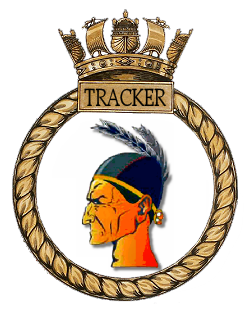 Description
Shape:
Standard, circular.
Blazon (Heraldic description)
On a white field: The head of a red Indian couped at the neck, habbited in a cap of leather bearing two fronds over the scalp secured with a ribbon, red.
TRACKER: A person who tracks someone or something by following their trail. The design was suggested to the ship’s officers by her builders, Willamette Iron & Steel, and is possibly a warrior of the Multnomah people, the Native American people indigenous to the Portland area of Oregon. It was accepted by the College of Arms and approved in 1943.
For explanations of heraldic terms see the Badges & Honours page.
Motto:
"RE RAWIRA"
I am on the warpath
|
|
Pennant Numbers:
D24
(Atlantic)
R317
(Pacific)
Battle Honours:
ATLANTIC 1943-44
ARCTIC 1944
NORMANDY 1944
|
|
|
Specifications
Builder: Seattle-Tacoma Shipbuilding Co. Tacoma, Washington
Completed by:
Willamette Iron & Steel, Portland, Oregon.
Displacement: 14,170 tons
length (Overall): 486ft
Beam: 69ft 6in
Flight deck: 442ft x 80ft wood covered mild steel plate
Propulsion: 2 Foster Wheeler boilers; 1 x Allis-Chalmers
geared turbine driving 1 shaft
Speed: 18.5 knots
A/C Capacity: 20
Hangar: 262ft x 62ft x 18ft
A/C lifts: 2; aft 34ft long x 42ft wide; forward 42ft long x
34ft wide
Arrestor wires: 9 with 3 barriers
Catapult: 1 x H2 hydraulic
Armament: 2 single 4in USN Mk 9, 4 twin 40mm Bofors, 8 twin
20mm Oerlikon, 10 single 20mm Oerlikon
Crew Complement: 646
Commanding Officers:
Lt. Cdr. C.G. Hudson RN as OIC
May 42 - Sep 42
Capt. G.C. Dickins RN
Sep 42 - Aug 43
Capt. D.S. McGrath
Aug 43 - Dec 4II
Capt. J.H. Huntley RN
Jan 45 - Nov 45
Squadrons:
816
Aug - Dec 43
Swordfish II/
Seafire Ib
846
Jan-Jun 1944
Avenger I/Wildcat V
853
Sep -Dec 1944
Avenger II/Wildcat IV
Listen to this section

|
|
|
|
A History of HMS TRACKER
|
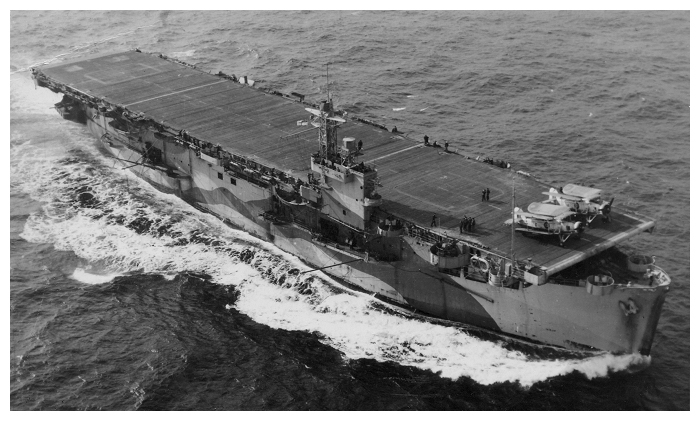 |
HMS TRACKER with two of 816 squadron's Swordfish
parked forward on the the flight deck |
Laid down on November 3rd 1941, at Seattle-Tacoma Shipbuilding Co. Tacoma, Washington, as a C3-S-A1 type freighter MORMACMAIL For the US operator Moore-McCormack Lines; Maritime Commission hull number 233, Seattle-Tacoma hull number 17. The MORMACMAIL was purchased by the US navy was purchased by the US navy for conversion to an auxiliary aircraft carrier BAVG-6, to be transferred to the Admiralty on loan on her completion under the Lend-Lease scheme. The hull was launched on March 7th 1942 after 124 days on the Ways, and was assigned to Willamette Iron & Steel, Portland, Oregon, for the completion of her construction as an escort carrier. She spent the next 330 days under construction in the water.
An advance party of her RN crew, under the command of Lt. Cdr. C. G. Hudson, sailed from the UK in autumn of 1942, landing at New York; they were temporarily accommodated at RN Camp Peekskill, New York state, before crossing the US by train to Portland. Once at Portland they were billeted ashore until the ship was sufficiently outfitted to accommodate personnel on-board.
|
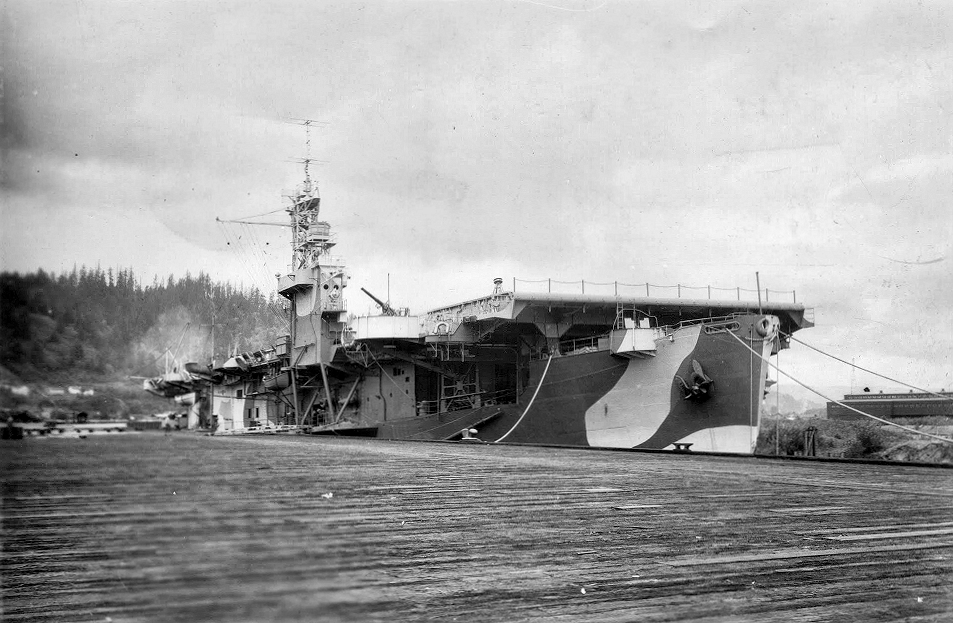
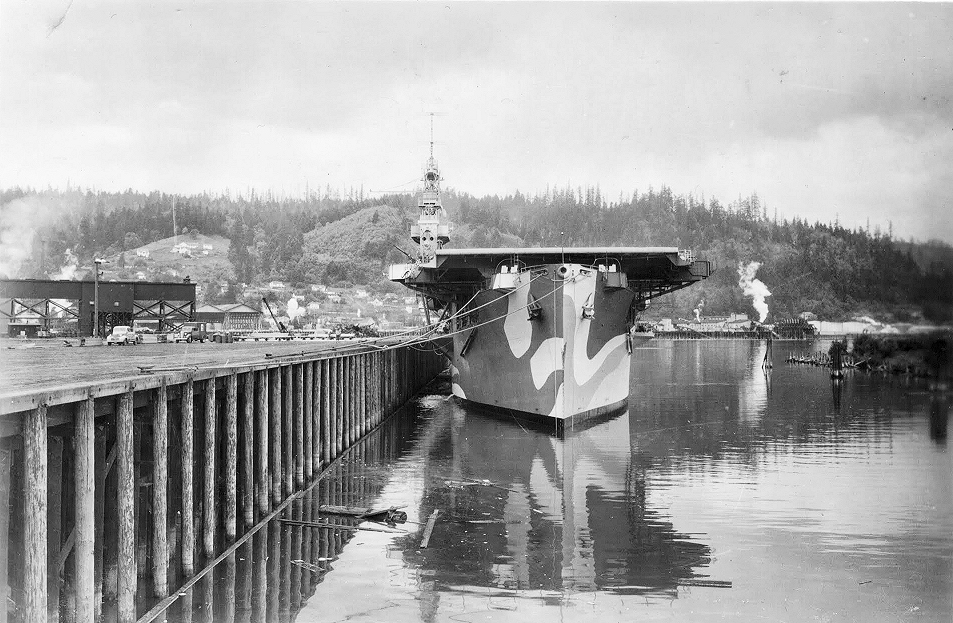 |
BAVG-6 moored at the Willamette Iron & Steel quay ready for her sea trials.
|
BAVG-6 sailed on her builder's sea trials and Admiralty acceptance trial at 08:00 on the morning of Thursday January 14th 1943. The acceptance trial was carried out by a four man board of naval officers who re-check the findings of the Builder's trials and more. Rear Admiral Noyes USN headed the trial board two captains and a lieutenant-commander completed the board. Also present on board TRACKER for these runs were the RN officers and crew, and a big force of Willamette Iron & Steel corporation workmen, Commander Leiand D. Whitgrove, the local supervisor of naval shipbuilding, together with members of his staff, and a group of Willamette officers.
After passing down the Willamette River she entered the Columbia River and trials began at 09:00. The first test was a full power run and speed run over a measured mile, downstream, turning around at 10:40 and repeated the runs upstream completing her maximum speed run over a measured mile commencing at 13:20 with an emergency stop. After testing her anchors, steering, engines, and general handling she returned to her berth at 16:00 after completing the test schedule.
On completion of defect rectification and final fitting out, a total build time of 454 days, BAVG-6 was delivered to the US navy and transferred to the United Kingdom at a ceremony held on the flight deck. At 14:55 the ship was accepted from Willamette Iron & Steel on behalf of the US Navy by Commander Meagher, USNR, and after the playing of the American national anthem he delivered her to Commander Godfrey C. Dickens RN who accepted her on behalf of the Admiralty.
BAVG-6 was commissioned into RN service in a short ceremony begin gig at 15:00 when Commander Dickens read out the commissioning warrant and the ship was named HMS TRACKER by Mrs James Macdonald, wife of the British Consul at 16:03. The Ship’s company were called to attention and honour guard was called to present arms at 15:04 as the White ensign and the Union Jack were hoisted while the British national anthem was played. Also in attendance was Lieutenant Commander Henry Gardner RN, the British Liaison Officer for the Port of Portland and senior corporate officers from Willamette Iron & Steel Corporation. This was a very auspicious event for the shipyard, TRACKER was the first escort carrier they had completed, and she was also the first to be produced for the RN by a Portland shipyard. For her Ship's badge TRACKER took the image of an Indian brave of the Multnomah Tribe, whose home was near the Columbia River in Oregon.
|
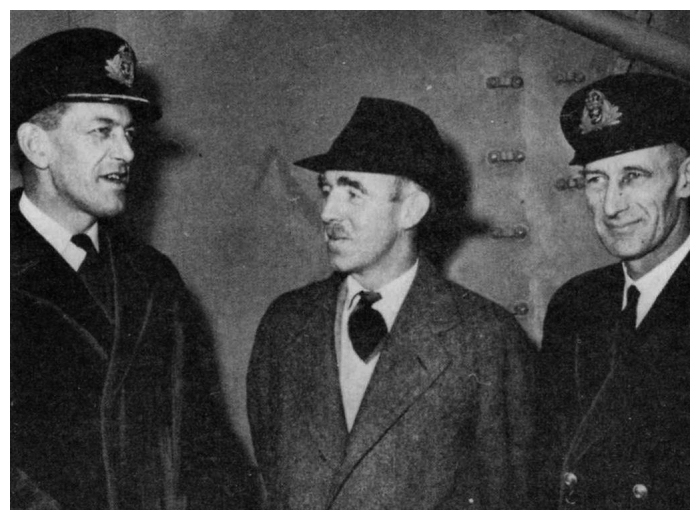 |
Taking over command of HMS TRACKER, Commander G. C.
Dickins RN poses with Mr. James McDonald, British Consul
in Portland, and Lieutenant Commander S .K. Horn RN
aboard the ship. |
Maiden voyage: Seattle to Belfast via Casablanca
On completion of storing ship TRACKER left Portland on February 27th 1943 and secured alongside at US Navy Air Station Seattle on March 1st. On the 4th she sailed for a round trip to the Puget Sound Navy yard, Bremerton, Washington to ammunition the ship arriving back on the 8th. She sailed from f Seattle on March 12th bound for or Balboa, to enter the Panama Canal, arriving on the 23rd. On reaching the Atlantic side she sailed form Cristobal on March 25th for US Navy Yard Norfolk, Virginia, without waiting for a US navy escort; she arrived on the evening of March 28th.
|
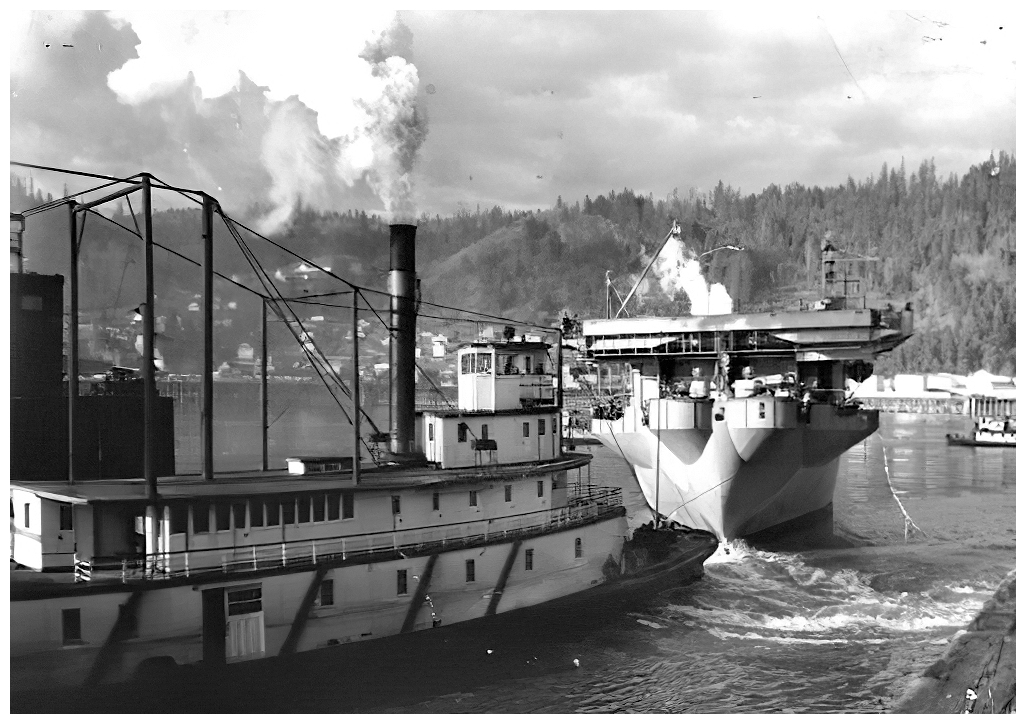 |
HMS TRACKER leaving the quayside at Willamette
Iron & Steel, Portland, Oregon with the aid of
paddle tugs to proceed out to sea. |
Sailed Norfolk for New York April 1st. She was to spend the next three weeks in the New York area, leave was granted on arrival. On April 20th TRACKER undertook live firing of her Oerlikon 20 mm cannon and Bofors 40 mm guns carried out at the Narragansett sea range off Block Island in Rhode Island Sound. Another live firing exercise was conducted on the 24th. On returning to harbour she embarked a consignment of 68 non-operational USAAF aircraft and stores for delivery to Casablanca, North Africa.
TRACKER sailed from New York on April 29th joining the 22 merchantmen and 10 escorts of convoy U.G.F.8 bound for Oran. On reaching the North African coat TRACKER detached and entered Casablanca harbour on May 10th. After unloading her cargo of aircraft she sailed in company with USS MERRIMACK and escorts USS GILLESPIE and USS CARMICK on May 12th bound for Gibraltar.
TRACKER was to spend the next 17 days alongside at Gibraltar before sailing for Belfast on May 30th. She joined convoy MKF.15 (Algiers to the Clyde) in company with the maintenance carrier UNICORN and destroyers JAVELIN and KELVIN. She entered Belfast Lough on June 5th 1943 and all those not required for duty received a 21 day leave once the ship was squared away.
Modification to RN standards and working up June - September 1943
TRACKER now entered the dockyard of Harland and Wolff to be modified to meet RN standards before entering full service. This work included the lengthening of the flight deck, installing British Type 79B aircraft warning and Type 272 surface search radars, replacing the US 5in gun mountings with British model. Modifications to hangar, accommodation and store rooms, installing extra safety measures including major changes to the aviation fuel stowage and oiling at sea arrangements, modifying gunnery and other internal communications, adding extra W/T and R/T sets, and improved darken ship arrangements. The work was to take two and a half months; on completion of the dockyard work, she sailed to conduct post refit trials and work up with aircraft in the Clyde training areas.
The first aircraft to visit he ship was Swordfish P4213 of 778 Service Trials Squadron making its first landing on August 9th and operated with the ship until the 11th carrying out deck landing trials. Two days later the Swordfish and Seafires of 816 squadron flew out from
RNAS Maydown, Northern Ireland to join the ship.
The next few weeks saw TRACKER working up in the firth of Clyde, conducting extensive flying exercises to work up the ship's air department. This period was marred by two serious accidents; the first occurred on August 26th during a night Deck landing Training (DLT) session, Swordfish DK683 failed to catch an arrester wire and missed the crash barrier to disappear over the side killing two of her three man crew; the Observer Sub Lt. R. Boakes RNVR and Telegraphist Air Gunner, leading Airman G. N. Jenkins were both killed, the pilot Sub Lt. A. E. White RNVR was rescued. The second incident resulted in Captain Dickens being evacuated ashore to hospital after suffering serious injury while inspecting the ships aircraft accelerator (catapult) mechanism. He was relieved by Captain D. S. McGarth, RN. A former Destroyer Skipper he would soon come to be known colloquially as "Dangerous Dan" - the black Van Dyke bearded Captain had a habit of entering harbour at full speed!
There were several landing incidents on September 2nd as the ship carried out intensive DLT for both her own squadron and for pupils from 768 DLT Sqn at
RNAS Machrihanish. Swordfish DK718 of 768 Sqn flown by Lt. CDR J. S. Bailey RNVR entered the barrier, as did Seafire Ib NX905 of 816 flown by Sub-Lt C. B. Taylor RNZNVR. Two other Seafires made heavy landings stressing their undercarriage, Sub-Lt G. Y. Hooper RNZNVR in NX988, and Lt. G. P. Magwood RNVR in MB375.
Atlantic convoy escort duty: September – December 1943
On completion of her work up TRACKER was allocated to Western Approaches Command for Trade Protection duty. Outfitted as an Anti-Submarine Warfare (ASW) carrier TRACKER carried out twelve convoy escort runs on transatlantic, Russian and Gibraltar routes between September 1943 and November 1944.
TRACKER sailed from the Clyde on September 23rd to join the Canadian 4th Escort Groups (E.G. 4) on her first operational voyage, and provided air cover for the outbound convoy ON.203 Liverpool to New York beginning on the 25th; she switched to the 2nd Escort Group (E.G. 2) to provide air cover for the west bound convoy HX258 Liverpool to Halifax and west bound HX.258 New York to Liverpool from the September 30th to October 2nd before returning to the Clyde, 816 disembarked to
RNAS Machrihanish on October 6th.
|
.jpg)
.jpg) |
C. October 1943 Left, Swordfish 'B' of 816 squadron
being prepared for flight, the wings are being unfolded
© IWM (A 19719). Right, Seafire 'Q' has just been
brought up from the hangar on the aft lift and is being
ranged on deck. Note, the Seafire Mk.Ib did not have folding wings. © IWM (A 19710) |
TRACKER next sailed from the UK into a period of stormy weather; 816 had re-embarked on October 17th just ahead of a South-westerly gale, taking shelter at Meville, Northern Ireland she had weighed anchor on the night of October 18th, being unable to maintain her position in the worsening weather she proceeded to rendezvous with E.G. 2 and the outbound convoy ON.207, Liverpool to New York, beginning air cover on the 23rd, switching to cover HX.262, New York to Liverpool starting on the 28th.
On November 1st E.G.2 and TRACKER detached to cover convoy HX264 but encountered a South-easterly gale which caused havoc for TRACKER. The Bogue class CVEs were notorious for their tendency to roll in rough seas and TRACKER was no exception; at one point she recorded a 52 degree roll and aircraft and stores broke free in the hanger. By the time she had recovered only three serviceable aircraft remained, the others were in various states of repair after crashing into each other and the bulkheads. Little flying could be achieved during this period, even if serviceability was not an issue, some sorties were possible on November 2nd but another gale blew in on the 3rd. After three weeks at sea, and 6,570 miles steamed, TRACKER and her escorts sailed into harbour at Argentia, Newfoundland on November 12th.
TRACKER had need of dockyard maintenance after her last trip and she disembarked her squadron to the R.N. Air Section at
USNAS Argentia on the 14th when she sailed for the US Naval dockyard at Norfolk, Virginia. After receiving repairs and a repaint, TRACKER arrived back at Argentia on December 9th.
After re-embarking her squadron TRACKER sailed with E.G.2 to cover convoy HX.270 beginning cover on the 15th. Again bad weather resulted in little flying; one scramble to intercept an aircraft saw TRACKER execute a tight 180 degree turn into wind to launch fighters - the first Seafire got off cleanly, but the second got caught by the roll out of the turn and flipped over, breaking its back. The intercept turned out to be a friendly. TRACKER detached from the convoy the 24th and headed for the Clyde where Christmas dinner was served and a ship's concert was put on. The celebrations over, TRACKER put to sea again on December 28th, and 816 squadron departed the ship for the last time, flying off to
RNAS Donibristle.
Working up and convoy escort duty: January – March 1944
On January 4th 1944 a new squadron joined the ship, 846 squadron which embarked from
RNAS Machrihanish. Her new squadron brought two American aircraft types aboard, being equipped with 12 Avengers (torpedo, bomber, reconnaissance) and the 4 Wildcat fighters of 'B' flight of
1832 squadron. After working up with the new squadron TRACKER was to be employed on anti-submarine sweeps on the Gibraltar convoy route. A new commanding officer arrived on January 17th 1944 when Captain J, H. Huntley, RN relieved Captain McGrath.
During the work up period there were four flying accidents, two involving Avengers, and two Wildcats; the first was on January 7th when Lt. J. E. Scott RNVR, crashed on deck landing in Wildcat JV333, he was OK. The second incident was fatal; on the 10th Avenger FN828 crashed into the sea after its starboard wig broke off making an exercise glide bombing attack on the ship, possibly due to exceeding the maximum speed limitations, killing the pilot Sub-Lt G. A. Houghton RNVR, the Observer Sub-Lt E. B. Dixon RNVR, and Gunner Leading Airman R. F. Gates, and a passenger Ordinary Seaman G. A. Smith. On the 13th Sub-Lt G. W. McCabe RNVR in Wildcat JV348 landed with his arrester hook up and entered the barrier, he was Ok. An unidentified Avenger crashed on take-off on the 20th, the aircraft veered into the port catwalk and its engine broke away from its mounts, the fuselage fell overboard; the pilot Sub-Lt S. J. Martin RNVR & crew were safely picked up by the plane-guard destroyer CLOVER.
After working up with 846 TRACKER began operations west of Finisterre from February 12th, working with a second escort carrier HMS BITER, they were to operate as Air Group A.2; this was new Admiralty policy, two carriers operating together, one anti-submarine and one a fighter carrier in support of Ocean Escort Groups.
Convoy ONS.29 and OS.68/KMS.42, these three convoys departed from Liverpool on February 12th, ONS.29 for Halifax and OS.68/KMS.42 for Freetown/Gibraltar. BITER and TRACKER initially supported escort group B4 covering ONS.29 while on passage to their rendezvous with the escort groups for the combined Freetown/Gibraltar convoy. The wind dropped on February 18th, the convoy was becalmed in the Bay of Biscay - normally famous for its atrocious weather conditions; flying was almost possible, TRACKERs Avengers were grounded but Wildcats could still be catapulted despite the lack of wind over the deck. One Avenger did attempt a take-off on the 20th; Sub-Lt S. I. Martin, RNVR in FN802 ('Q') attempted an un-accelerated take-off but went over the side; he was smartly picked up by CLOVER.
Eventually the weather improved and the Avengers resumed their sweeps, up to 200 miles deep, finding no contacts. On February 23rd the two convoys separated; OS.68 with 29 vessels continued its passage on to Freetown, KMS42G with 27 ships arrived at Gibraltar on the 25th. The escort group was to spend a week at Gibraltar, and during this time 846 squadron flew ashore to RN Air Section North Front, re-embarking on March 2nd when the ship sailed to meet the next convoy.
|
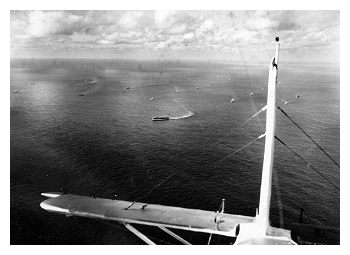 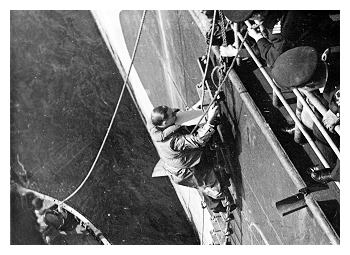 |
Left: The ships of convoy SL-150,/MKS-41 heading for the
UK escorted by TRACKER and BITER - BITER is turning to
starboard after leaving the formation to launch a
Swordfish from which this shot was taken. Right: Surgeon
Lt. Cdr G. Foss, and Surgeon Lt. H. King RNVR from HMS
TRACKER boarding HMS BITER in the Bay of Biscay to
assist BITER's medical staff. Photos: John Crowther |
Convoy SL150/MKS41 this combined convoy formed at sea off Gibraltar on March 3rd when Freetown to UK convoy SL.150 rendezvoused and joined with MKS.41, from Gibraltar to the UK.
BITER, TRACKER, and escorts sailed on the 2nd to be at the rendezvous point. Flying was again hampered by a lack of wind; this was an asset on the evening of March 5th however, when TRACKER's Doctors, Surg Lt. Cdr George Foss, and Surg. Lt King RNVR, a South African went over to
BITER by sea boat to assist with a delicate surgical operation.
SL150/MKS41 was a slow moving convoy with little incident until an explosion occurred at 01:54 hours on March 10th to the west of the Bay of Biscay; U-575 had attacked the convoy and sank the Flower Class Corvette HMS ASPHODEL. Four of TRACKERs Avengers searched for the attacker but no trace was found.
BITER and TRACKER detached from the convoy on March 11th and proceeded to the Clyde in company with her close escorts HM Ships WHITEHALL and WRESTLER, arriving on March 12th. The combined convoy reached Liverpool on March 13th. One weeks leave per watch was announced two days later, as the ship took a short breather before switching convoy routes for her next trip.
Russian Convoy escort JW58 to Murmansk & RA58 to Loch Ewe: March - April 1944
This was to be a round trip to Murmansk, Northern Russia, escorting the outbound convoy JW58 and the return convoy RA58. TRACKER joined the British built escort carrier
ACTIVITY (819 squadron operating 3 Swordfish and 7 Wildcats) for this tri-p and the two carriers sailed from the Clyde for Loach Ewe on March 25th. Arriving at Loch Ewe on the 26th they joined the Cruiser DIADEM (Flag of Rear Admiral Commanding, Tenth Cruiser Squadron), the three ships sailed for Scapa the next morning, arriving there later on the 27t. On the 28th DIADEM,
ACTIVITY, TRACKER, USS MILWAUKEE (being delivered to the Russian Navy, under Lend-lease agreements), HM destroyers VENUS, SERAPIS, STORD, and SCORPION left Scapa to join the escort of JW 5, the convoy of 47 ships left Loch Ewe on the 27th, and rendezvoused on the 29th.
The enemy was engaged on the 30th when Wildcats from ACTIVITY’s 819 Sqn, FN122 (‘P’) flown by Lt J. G. Large, and FN135 (‘Q’), flown by Sub-Lt R. K. L. Yeo RNVR, intercepted and shot down a Ju88 at position 67°0'N 3°9'W.
On the 31st three Fw200 long range reconnaissance aircraft were intercepted and destroyed; Wildcats from 819 Sqn, Sub-Lt L. A. S. Swift RNVR in JV522 (‘R’) and shared with Sub-Lt N. .M. Simon RNVR in JV601 ('Z') shot one down at 69°29' N 0°27' W; Sub-Lt R. H. Meed RNVR in JV490 (846 Sqn)and Sub-Lt G. C. Debney in JV485 (819 Sqn) Wildcats shot down a Fw200 into the sea in position 70°18'N 00°02'E; Sub-Lt Swift in JV522 (‘R’) shot down his second at position 70°20'N 1°30'W shared with an unnamed pilot in JV391 ('S'). On the same date Sub-Lt T. D. Lucey RNVR wrote-off Wildcat JV388, crashing into the barrier landing on TRACKER.
On April 1st a serious and dangerous accident occurred aboard TRACKER; at 09.52 Avenger FN877 (L) sighted a U-Boat on the surface and attacked - only to find that he could not release his depth charges. The U-Boat dived, and the aircraft was recalled. Approaching the ship he reported that three of the four weapons had gone and came into land; despite frantic signals to "go around again" from the Deck Landing Control Officer, Sub Lt. Ballentyne RNVR, the pilot flew straight into the round down, at full throttle. The aircraft ended up with its engine buried in the round down and the tail hanging over the stern, the aircraft balanced with the port wing resting on the Bofors mounting; the whole aircraft was immediately a mass of flames. One member of the gun crew, Seaman John Forrester, received slight burns, but was very soon back on duty - the rest of the gun crew had sought shelter when the crash looked imminent. A serious fire now burned on the after end of the flight deck and it was believed that a depth charge was still on board the aircraft; the ship's Torpedo Officer, Lt Malone RNVR cleared the ship's own depth charges out of harm’s way.
|
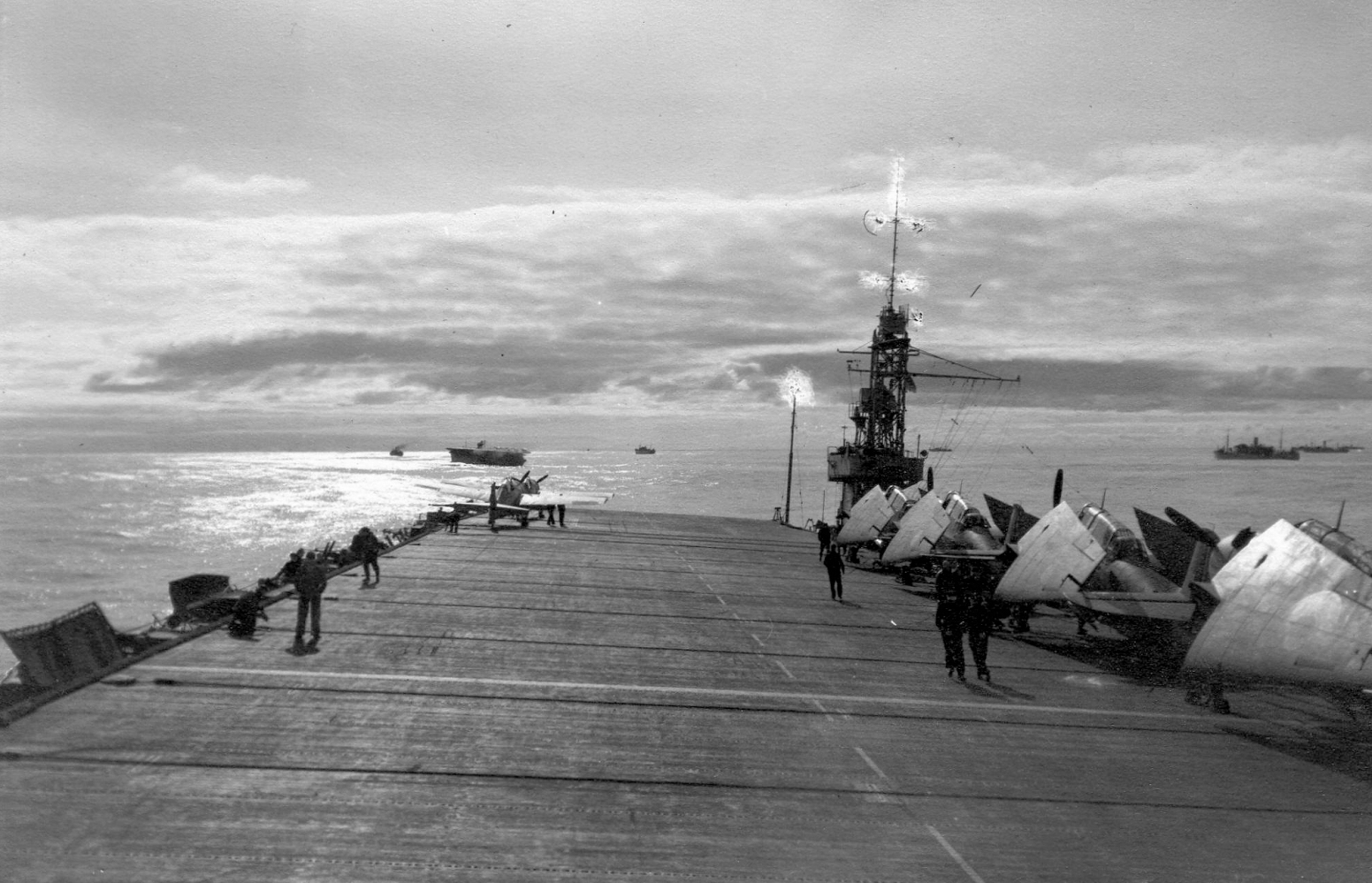
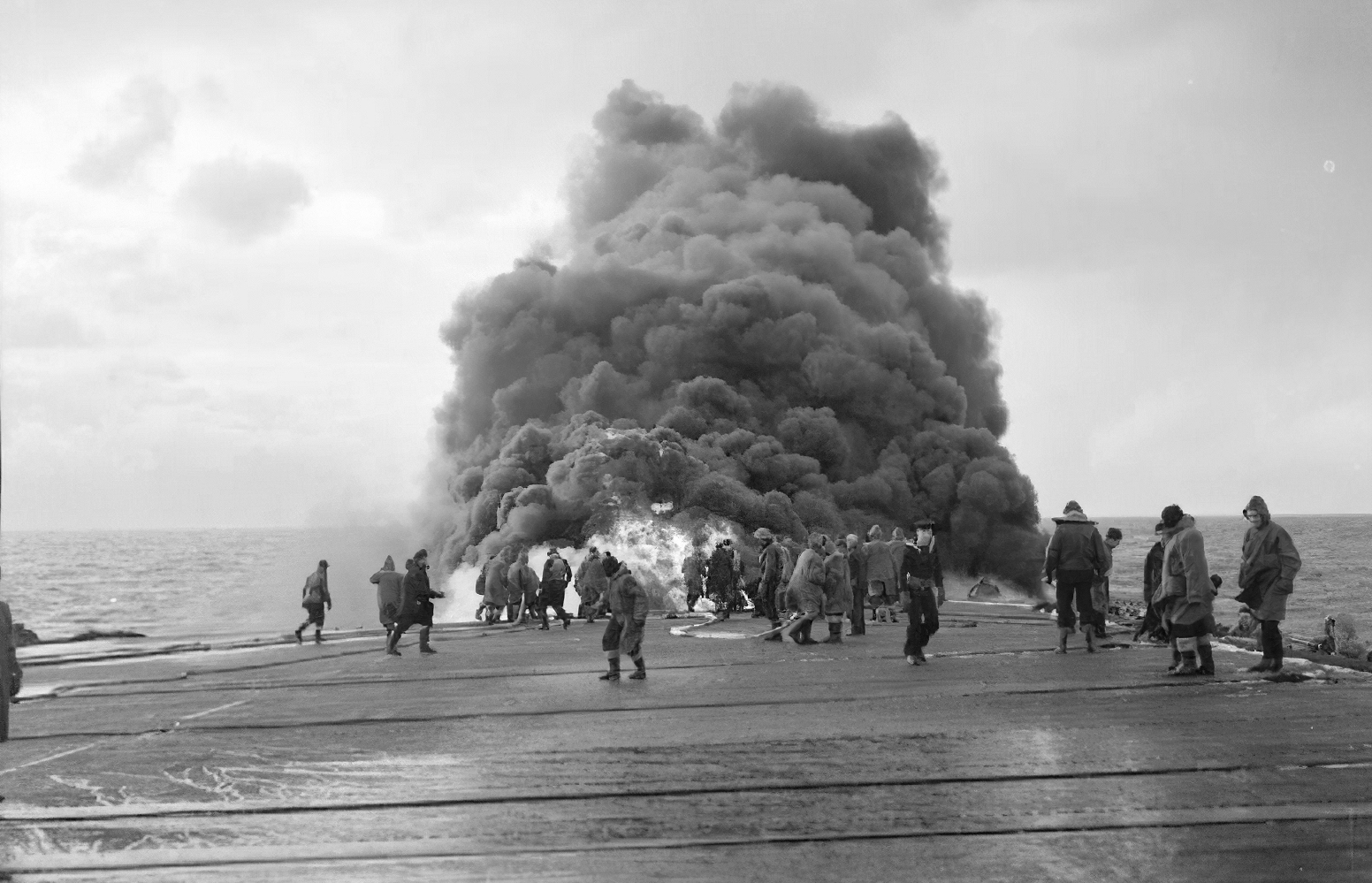 |
April1944 TRACKER in convoy with the Avengers of 846 parked along the starboard side of the flight deck and a Wildcat on the accelerator at readiness to launch. Right, April 1st a major fire on the aft of the flight deck after the crash of Avenger FN877 (L) which hit the rounddown and burst into flames before falling back into the bofors mounts below. © IWM (A 22864
|
The crew of the blazing Avenger had somehow stumbled out, but the Pilot Sub Lt. Ballentyne, was a mass of flames. He stumbled blindly into the hanger, where P.O. Hayes and A.B. Day extinguished the flames; unfortunately he was dead on arrival at sick bay. The fire on the quarter deck was now a serious affair, ammunition in the both the crashed aircraft and the Boors ready use locker was popping and exploding as the Avenger broke up; the engine toppled on to the Quarter Deck, which helped reduce the fire on the flight deck but increased it down below. Fire crews and damage control parties had hoses playing from every vantage point and the fire was out in fifteen minutes. The one depth charge had not exploded - it seemed that Sub Lt. Ballentyne must have ditched all four, not three as he thought. Sub Lt. Ballentyne was buried at sea on the same evening, all ships in the convoy lowering their ensigns as a mark of respect as the honour guard fired the salute. Of the two other crew members the Observer Sub-Lt K. D. Callaway RNVR was badly burned; and the Gunner Leading Airman G. E. Hearn was severely shocked. Later that same day another pair of Wildcats claimed a Bv138 seaplane shot down in flames in position 72°37'N 9°50'N, shared by Lt P. E. Scott RNVR in JV512 (846 Sqn) and Sub-Lt G. R. Willcocks RNVR in FN136 ('T') (819 Sqn).
846 Squadron lost two more aircraft on April 2nd; one was written off in a barrier crash, JV333 flown by Sub-Lt McCabe, the other ditched at position 73°N 28° - Sub-Lt T. D. Lucey, RNVR in JV420 made a strafing attack on a U-Boat on the surface and came in too low, striking the conning tower, he was rescued by BEAGLE after 1 hr 55 min in the freezing waters.
Another U-Boat was sighted on the surface by Swordfish LS373 ('C') of 819 Sqn on April 3rd; this was U-288. Lt. S. Brilliant RNVR and his crew, Sub Lt. H. .Chadwick RNVR and P.O. Airman J. Perry came under heavy anti-aircraft fire and called for assistance. They were joined on the scene by Avenger FN869 ('4G' Lt J. S. Toner RNVR, Lt R. A. Woodward RNVR & Leading Airman M. Greenfield)) and Wildcat JV512 flown by Sub-Lt G. W/ McCabe RNVR from TRACKER’s 846 squadron and combined depth charge and rocket attacks were carried out. Despite evasive manoeuvres U-288 was sunk in position 73°44'N 13°04'E in the Barents Sea southeast of Bear Island. Lt. S Brilliant, Sub Lt. H Chadwick were both awarded the DSC, while P.O. J Perry was awarded the DSM for this action.
JW59
reached Vaenga Bay, Kola Inlet without loss on April 4th, ACTIVITY
and TRACKER detached from the convoy and anchored in Kola Inlet. he
return convoy, RA58 sailed from Vaenga Bay on April 7th, tis
comprised of 38 ships escorted by DIADEM (Rear Admiral Commanding,
Tenth Cruiser Squadron), ACTIVITY, TRACKER, SAUMAREZ, ONSLOW,
OPPORTUNE, ORIBI, OFFA, OBEDIENT, ORWELL, IMPULSIVE, VENUS, SERAPIS,
STORD, SCORPION, KEPPEL BOADICEA, WALKER, INCONSTANT, WESTCOTT,
WHITEHALL, WRESTLER, BEAGLE, HONEYSUCKLE, BLUEBELL, RHODODENDRON,
STARLING, WHIMBREL, MAGPIE, WREN, and WILD GOOSE.
The convoy arrived at Loch Ewe without suffering any losses, ACTIVITY escorted by WESTCOTT, WRESTLER, WHITEHALL, and INCONSTANT detached for Scapa on the 12th, TRACKER escorted by HONEYSUCKLE, RHODODENDRON, and BLUEBELL detached from convoy to the Clyde on the 13th arriving on the 14th. TRACKER proceeded to Belfast to entered Harland & Wolf's dockyard on the 16th for repairs to her fire damage.
With her repairs complete and a short leave enjoyed by those who could be spared, TRACKER left Meville on April 29th to sweep the Western approaches with E.G. 2. TRACKER suffered more storm damage on this duty spell, losing her radar aerials in a gale and necessitating the ship's four PO Radar Mechanics to risk life and limb in the upper works making good repairs. TRACKER was to spend several weeks in May in the Floating Dock at Greenock before being assigned a small role in the D-Day invasion plans.
D-Day anti-submarine sweeps: June 1944
TRACKER left the Tail O' the Bank on June 3rd carrying
the 12 Avenger of 846 Squadron and 8 Wildcat fighters; 'L' Flight of
1832 Squadron had been attached on May 13th 1944 at
RNAS Machrihanish doubling the fighter contingent (these were absorbed into 846 shortly after this as 1832 disbanded on June 1st). On June 5th all available hands were employed to paint all the aircraft with the black and white "Bumble Bee" recognition stripes that all allied aircraft were to wear for the invasion.
TRACKER, joined the CVEs
PURSUER and
EMPEROR for operations in the western approaches as part of the cover forces for operation NEPTUNE. The carriers were employed in a position 150 miles west of Lands' End to carry out anti-submarine patrols to intercept U-Boat attempting to enter the English Channel for attacks on invasion traffic. The 1st, 2nd, 5th, 6th, 9th, 11th, 14th, and 15th Escort Groups were also deployed in this area to provide additional support.
On the night of June 10th. TRACKER and the Canadian frigate HMCS TEME were in collision in the dark of the night; TEME was chasing down a U-boat contact and swept clean across TRACKER's bows. As both ships were in darkened ship routine and so hard to spot - TEME switched on her navigation lights when it appeared that collision was inevitable and TRACKER gave two warning blasts on her fog horn. The ships collided at approximately 02:00, TRACKER rammed TEME amidships and the two ships were entangled as the heavy swell pushed TRACKER forwards in a 'sawing' motion as if she was going to cut the TEME in two. . When eventually separated TEME, with a gaping hole, was taken in tow by HMCS OUTREMONT and made their way back to the UK. Four of TEME's crew had been killed in the tragic accident.
TRACKER was able to maintain her station despite her stove-in bows, and the next day flew off her aircraft, catapulting all 21 in the space of 40 minutes; TRACKER withdrew to Belfast on June 12th where the damage Inspection indicated the need for a refit; this was to be done in Liverpool.
|
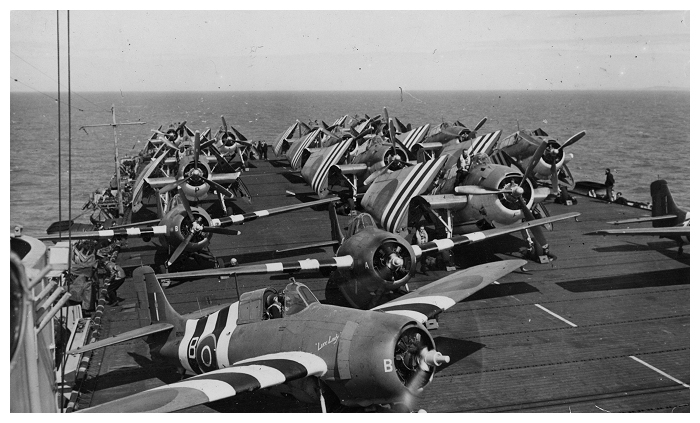 |
HMS TRACKER with 846 squadron embarked for
anti-submarine sweeps in support of the D-Day landings
in June 1944. Photo: Courtesy Clive Turner. |
Refit, a new squadron and a second Russian convoy run: July – November 1944
HMS TRACKER was to be in dockyard hands until early September, the refit involving more work that just repairing that which was damaged; part of the ship was fitted with tropicalized ventilation ducting and some of the defensive armament was replaced. The ships hanger also received some attention, a fire screen was installed to curtain off the two halves of the hanger in case of fire, and office space was created by utilising overhead space on the hanger deckhead.
TRACKER put to Sea again on September 7th to prepare to embark her new
squadron, 853, another Avenger/Wildcat composite squadron with 10 Avengers
and 6 Wildcats. The squadron flew out from
RNAS Machrihanish on the 12th and the next few weeks were spent working-up with
the ship, her Avengers making 200 deck landings, and her Wildcats 60. Flag officer Carrier Training (F.O.C.T), Vice Admiral Sir Arthur Lyster visited the ship during this exercise period. The Admiral and his staff found a well-honed fighting ship, her crew well rested (twenty-two days leave under their belts) and a new and efficient air squadron. The work-up complete 843 flew ashore to
RNAS Machrihanish on October 5th.
Although part of her refit involved
tropicalisation TRACKER's next operation (her tenth) was a return to the Arctic Circle; TRACKER sailed on October 14th 1944, re-embarking her squadron on passage to Scapa Flow to escort the round trip convoys JW/RA61 to Murmansk, codenamed operation TRIAL. She sailed from Scapa on October 21st as part of the escorting force comprising
VINDEX (Flag, RA CS10, 811 Sqn, 12 Swordfish),
NAIRANA (835 Sqn, 14 Swordfish & 4 Wildcat), TRACKER (853 Sqn, 10 Avenger & 6 Wildcat), DIDO, ONSLOW (Captain (D) 17th Destroyer Flotilla), ORWELL, ORIBI, OPPORTUNE, OFFA, OBEDIENT. 8th Escort Group LARK, WALKER, LAPWING, CAMELLIA, OXLIP, RHODODENDRON, 15th Escort Group LOUIS, INGLIS, LORING, LAWSON, MOUNSEY, NARBOROUGH, 21st Escort Group CONN, BYRON, FITZROY, DEANE, RUPERT, REDMILL. Outbound convoy JW61 arrived at Kola inlet on the 28th without loss.
Local leave was granted but the run ashore at Kola Inlet was quite a shock to the system - those who went ashore found there was nothing to do, and nowhere to go. Everyone had to stay on the road, deviation from the road brought attention from armed Soviets soldiers- many of whom were women.
The return convoy, RA61 sailed form Kola Inlet on November 2nd, later that day HMS MOUNSEY was hit by an acoustic torpedo fired by U-295 forcing her to return to the Kola Inlet for temporary repairs. TRACKER detached for Scapa on the 9th, sailing for the Clyde the same day. She arrived on the 10th to undergo a boiler clean and leave was granted.
Loan to the US Navy as a transport carrier: December 1944 – July 1945
TRACKER left Greenock on Dec 8th 1944 and reached New York in time
for Christmas, she was to stay there until New Year's Eve when she
put to sea headed for the Panama Canal and reached San Diego on
January 17th 1945. Here the ship's company received the same levels
of hospitality they had enjoyed at Portland while the ship was being
built. Books, magazines, music, sports kit and more were donated to
the ship for the men's 'comforts' by the Red Cross and US Armed
Forces Institute.
After a
week in San Diego TRACKER moved to San Pedro for the next five days, and
opportunity was taken for the crew to experience Hollywood and film
stars 'popped in' to visit the ship. By the end of January
TRACKER was
full of aircraft and passengers bound for Hawaii and US bases in the
S.W. Pacific. Her first voyage in the transport role took her to the
Admiralty Isles and New Guinea in then back in San Diego, arriving back
there on March 20th. a round trip of 13,424 miles taking two months. On
the return trips TRACKER carried US personnel and casualties back to
Pearl Harbour.
Her second
transport run was to Guam and Saipan in the Mariana Islands in April,
during this trip the news of President Roosevelt's death reached the
ship and her US passengers, a memorial service was held on board. VE
day, May 8th, was celebrated on the last leg from Hawaii three days out
from San Diego and the end of a 13,020 mile trip.
TRACKER's
third trip took her to the Marshal Islands and back - a shorter, 10,000
miles haul from June 12th to July 8th. This was her last operation for
the US Navy, she had ferried 300 aircraft and 100 passengers in her
three voyages, and had steamed 36,000 miles across the Pacific. After
storing ship TRACKER was to proceed back to the UK.
TRACKER
left San Diego on Friday 13th having exchanged a few crew members with
her sister CVE Atheling, also on transport duties; those men on Atheling
who qualified for release under the recently announced 'Age & Service
Release Scheme', TRACKERs 'newbies' filling their billets.
TRACKER
reached Norfolk, Virginia on July 27th and on to New York arriving on
July 30th. Here eighteen members of the crew, all Newfoundlanders, left
the ship bound for home leave, and probably demob.
Homeward bound and paying off
This
was to be TRACKER's last east bound crossing, carrying on board
American wives of British Naval personnel, children evacuated from
the UK, and over a hundred members of the Fleet air Arm from the air
station in New Brunswick which was closing down. TRACKER reached
Greenock on August 9th and disembarked her passengers; Work began
almost immediately de-storing TRACKER in preparation for her final
voyage, her return to the US Navy, her service with the Royal Navy
coming to an end.
HMS
TRACKER, CVE-6 arrived at Norfolk, Virginia, November 29th 1945, and was
decommissioned before being returned to U. S. Navy custody. She was sold
to Rio de la Plata S.A. de Navigacion de Ultramar, Buenos Aires, between
1950 until 1964 she operated as the S.S.
Corrientes under Argentine registry. She was scrapped at Antwerp
starting 24 September 1964.
|
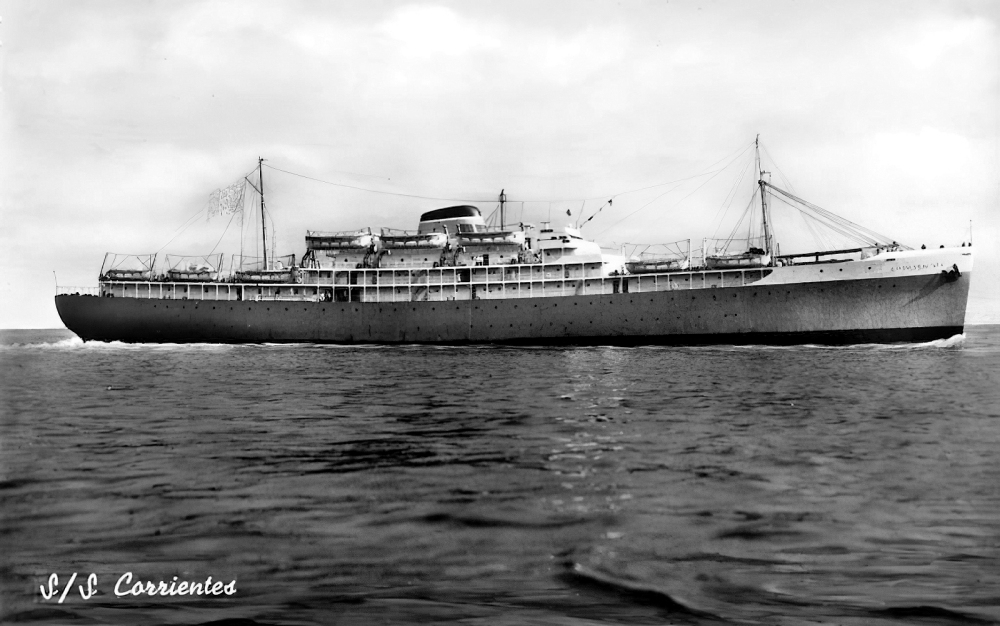 |
The immigration ship S.S. Corrientes |
Content revised:
19 June 2022
Sources used in compiling this account:
Click here for a list of
Primary sources
Additional sources:
Chaple, A. G. (1945) 'Good Fellows All' Portland, Oregon,
Metropolitan Press.
Gibbings, D (1989) 'HMS TRACKER & the Attacker Class Escort
Carriers' The Society of Friends of the Fleet Air Arm Museum
Fold3.com various documents including;
Admiralty War Diaries
US Naval Station, Seattle, Washington
US Naval Station, Manchester, Washington
Puget Sound Navy Yard War Diaries
US Thirteenth Naval District War Diaries
Norfolk Navy Yard War Diaries
Mew York Navy Yard War Diaries
Miscellaneous documents
|
Home
page |
go to the top
|
Comments (3)
I have documents captioned photos of many of the events described as recorded by then Gunner C.H. Humble aboard the Tracker from its possession in Portland to the Murmansk run (for which he received a Russian medal in 1999.If interested to preserve this history please contact me. Also his pictures of the surrender at Tokyo Bay and Nagasaki and Hiroshima in October 1945.
I have correspondence written by my great uncle, Noel Hunt, Lieutenant RNVR, in October 1944 when he was the Commanding Officer, HMS Tracker